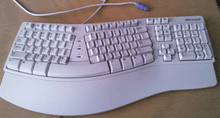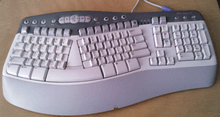Microsoft Natural keyboard
The Microsoft Natural Keyboard is an ergonomic keyboard for computers, introduced in 1994. It was designed for Microsoft by Ziba Design.[1] The keyboard was a split keyboard with each half of the keyboard separated and tilted upwards and down from the center of the keyboard. This key arrangement was ergonomically designed to prevent carpal tunnel syndrome and other repetitive strain injuries associated with typing for long periods of time. Another innovation was the integrated wrist pad helping to ensure correct posture while sitting at the computer and further reducing strain on the neck, arms and wrists. This keyboard also introduced three new keys purposed for Microsoft's upcoming operating system: two Windows logo keys between the Ctrl and Alt keys on each side, and a Menu key between the right Windows and Ctrl keys.[2] Although it was not the first ergonomic keyboard, it was the first widely available sub-$100 offering.[2] The keyboard gained popularity quickly, selling over 600,000 per month at its peak.[1]
As with most Microsoft keyboards, software (Microsoft IntelliType) is bundled for both Mac OS X and Windows, allowing users to customize the function keys and modify keys fairly extensively.
Natural Keyboard Elite

The Microsoft Natural Keyboard has had several upgrades and refreshes since its introduction. The first of these was the Natural Keyboard Elite, introduced in 1998. The Elite features a nonstandard layout of the key block normally found above the cursor keys. Another common criticism of the Elite is that the arrow keys' inverted-T layout has been changed into a cross-like layout, with left/right arrows keys side by side and up/down keys bracketing them from above and below, increasing the distance between the vertical keys. Another significant change was the keyboard's adjustable feet. While the original Microsoft Natural Keyboard had feet in the front, the Elite and its successors have their feet in the back. The Natural Keyboard Elite was manufactured in at least two different color schemes; white with black lettering and black with white lettering.
Natural Keyboard Pro
The second iteration was the Natural Keyboard Pro, introduced in 1999. The Natural Keyboard Pro retained the original inverted-T layout of the cursor keys, and gained a row of program shortcut keys along the top edge of the board, including multimedia keys and Power management keys. In versions of Windows prior to Windows Vista, Microsoft's Intellitype software is required to configure the behavior of the shortcut keys. Vista and Windows 7 have the ability to customize shortcut key behavior without additional software when using the "internet keyboard" keyboard layout. Some other modern operating systems, such as FreeBSD and most Linux distributions, have comparable configuration options. The Natural Keyboard Pro also included an internal two-port USB hub, which was commonly used to connect other input devices such as a mouse or trackball, but this was dropped in subsequent iterations.
Natural Multimedia Keyboard

In 2004, Microsoft introduced the restyled Natural MultiMedia Keyboard, which reworked the row of multimedia buttons and included the controversial F Lock feature, originally debuted in the Microsoft Office Keyboard. Another common criticism is that although the bunched arrow keys of previous generation has been fixed by returning to the standard inverted T layout, the Home/End/Del/Ins/Page up/down set has been changed to 3x2 vertical layout, with the Insert key moved to the "PrtScn/SysRq" key, and del key expanded. On the Natural Multimedia Keyboard, the status indicator lights for Num lock, Scroll lock, and Caps lock were moved from between the banks of alphanumeric keys to a more traditional location above and to the right of the backspace key. The Natural Multimedia Keyboard was manufactured in at least three different color schemes, including white with blue accents, black with silver accents, and white with black accents.
Natural Ergonomic Keyboard 4000

In September 2005, Microsoft introduced the Natural Ergonomic Keyboard 4000. This keyboard provides a significantly changed ergonomic design, including an integrated leatherette wrist rest, noticeably concave key banks, and a removable front stand to help straighten the wrist and allow the fingers to drop naturally onto the keys. The multimedia keys have again been redesigned, and the home/end key location set has been fixed by returning to the standard 2×3 horizontal rectangular layout. The F Lock key now defaults to "on", providing the original function key features rather than the new "enhanced" functions, and retains its setting across reboots. The 4000 has the indicator lights for Caps lock, etc. moved back to between the banks of keys, although they are now below the Space bar, rather than above. The 4000 is also significantly quieter to type on, with less of the distinctive "click clack" noise that is common with older keyboards. The space bar, however, has been reported by several reviewers to be unusually noisy and difficult to depress.[3][4][5][6] The 4000 is available in two variants, Business and Retail. The exact differences are not known, although product descriptions imply that the packaging is different, and prices are often slightly higher for the Business edition.
References
- ↑ 1.0 1.1 "Microsoft Natural Keyboard". Ziba Design. 1 February 1994.
- ↑ 2.0 2.1 FISHER, LAWRENCE M. (6 September 1994). "Microsoft Is Bringing Out Its First Computer Keyboard". The New York Times.
…the Microsoft Corporation will begin shipping a keyboard on Tuesday with a suggested retail price of $99.
- ↑ "Microsoft Natural Ergonomic Keyboard 4000 Review". The O-Factor. Retrieved 2008-06-13.
- ↑ "Microsoft Natural Ergonomic Keyboard 4000 Review". COSMiX.ORG. Retrieved 2008-06-13.
- ↑ "Microsoft Natural Ergonomic Keyboard 4000 Review". priscimon.com. Retrieved 2008-06-13.
- ↑ "Customer Reviews: Microsoft Natural Ergonomic Keyboard 4000". Amazon.com. Retrieved 2008-06-13.
External links
| Wikimedia Commons has media related to Microsoft keyboards. |
- Official website
- Technical datasheet for Natural Ergonomic Keyboard (pdf)
- PC World review written by Michael S. Lasky (posted October 25, 2005)
- CNet Asia review written by Felisa Yang (posted September 21, 2005)
- Review written by Xah Lee, 2006
- Coding horror review written by Jeff Atwood